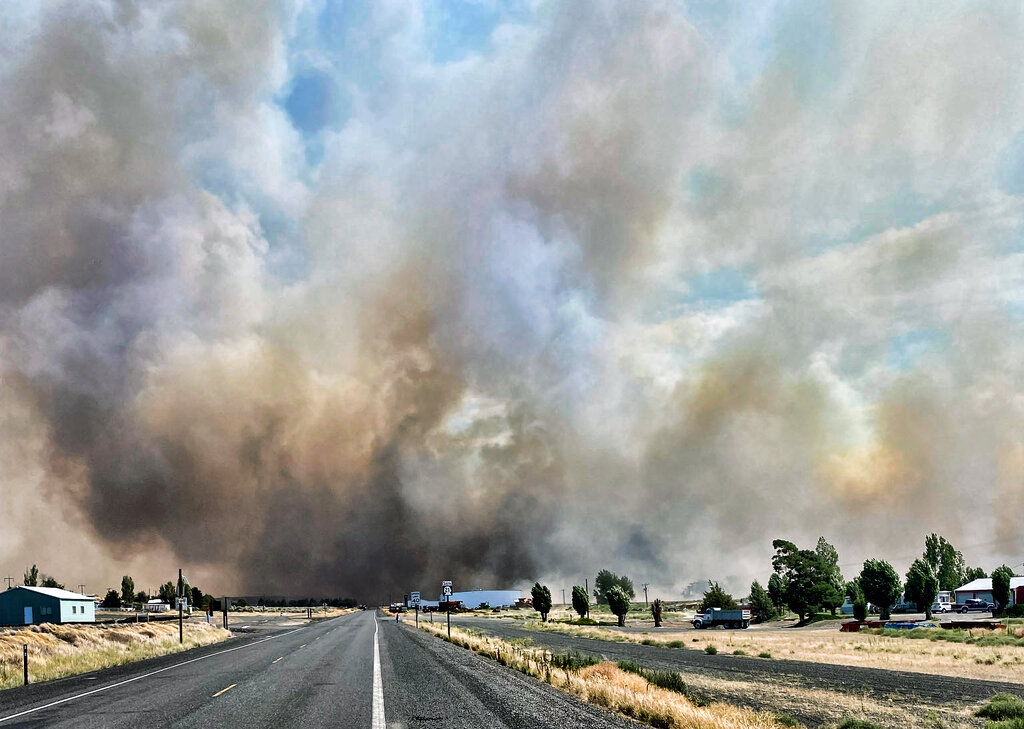When the wildfire smoke arrives, Harry Whitman has nowhere to go.
“When there’s smoke or there’s a fire, they lock you in,” Whitman said.
Whitman, president of the advocacy group Black Prisoners’ Caucus, is incarcerated at Airway Heights Corrections Center. The prison is located less than 10 miles away from Medical Lake, Washington, where Gray Fire burned about 10,000 acres just a month ago. When the fire arrived, Whitman said it looked like “someone had set off an atomic bomb.”
“You can’t see the sky, you can’t see the sun,” Whitman said.
“We knew the fire was coming,” he added. “But what could you do? Of course, DOC isn’t going to buy everyone an oxygen mask. Of course, they’re not going to move everybody to a place where there isn’t any smoke.”
At Airway Heights, Whitman said prisoners are confined to their cells when there’s wildfire smoke — and the ventilation system at the prison isn’t doing much to keep the air clean. Ventilation isn’t just a problem at Airway Heights. At facilities across eastern Washington during wildfire season, the smoke hangs so heavy in the air it looks hazy indoors, incarcerated people say.
The state Department of Corrections says they’ve requested heating, ventilation and air conditioning, or HVAC, updates for several facilities, but the state legislature declined to fund the majority of its requests in the past three years. They have another one pending ahead of the 2024 session.
However, advocates say Corrections has other funds to improve ventilation, pointing to $350 million in COVID funds and over $11 million in the Incarcerated Individual Betterment Fund, which is primarily funded by revenue from prison phone services.
“I just don’t know what they spend all that money on,” said Lindsay Hannula-Marjama, executive director of Families of the Incarcerated.
Corrections has used pandemic-related dollars to pay for just one HVAC project, according to the department. A spokesperson for the department, Chris Wright, said the agency’s COVID funds ran out in the last fiscal year and had to be used for projects “with direct COVID impacts.”
Wright also said the agency’s policy does not allow it to tap the Incarcerated Individual Betterment Fund for major construction projects.
Poor ventilation and health outcomes
Prisoners report coughing, constant nosebleeds, migraines and breathing problems during wildfire season, consistent with symptoms commonly associated with breathing smoke.
“There’s no medical attention for that sort of stuff. That’s just routine here because we have fires every year,” Whitman said.
Multiple studies have shown a decrease in lung function in healthy individuals exposed to wildfire smoke. Experts say wildfire haze can have consequences even long after it’s gone.
The state Department of Corrections offers N95 respirators to prisoners when wildfire smoke reaches its facilities. But according to the Washington Department of Health, if masks don’t fit properly, they provide little to no protection — and “most people will find it difficult to wear masks correctly.” N95 masks also do not provide protection against hazardous gasses in the smoke.
Talon Cutler-Flinn, who’s incarcerated at Washington State Penitentiary, says the ventilation system is so poor the air seems fresher outdoors than indoors, even during wildfire season.
“A lot of guys are getting their sinuses cauterized,” Cutler-Flinn said. “I was born and raised in Boise, I lived in Arizona for two years, you know, it’s 115 degrees — I never got bloody noses like I get here, it’s like every week.”
The issue is more acute for prisoners with asthma, bronchitis and other respiratory conditions that can have an “acute detrimental effect” to prolonged wildfire smoke exposure, leading to worsened symptoms such as acute asthma attacks and hospitalization. One study suggests wildfire smoke is more hazardous than other forms of air quality pollution to people with asthma.
In an informal survey conducted inside Washington State Penitentiary by Cutler-Flinn, prisoners with respiratory conditions said on questionnaires the smoke has made their condition worse. Some said they developed respiratory conditions like asthma and bronchitis while incarcerated.
“Any other comments?” Cutler-Flinn’s survey asks.
“Ain’t nothing gonna happen,” one reply reads.
Few HVAC projects funded
According to the Department of Corrections, there have been three HVAC upgrades funded by the Legislature in the past three years at two of the state’s 12 prison facilities: Washington State Penitentiary and Monroe Correctional Complex. However, none of the projects are finished yet. Since 2021, Corrections has requested but not received funding for nine other HVAC projects.
The department is now asking Gov. Jay Inslee and state lawmakers to approve about $4.2 million for HVAC systems and refrigeration as part of next year’s supplemental state budget.
“All facilities are requesting funds for numerous HVAC systems that are not working properly, not working at all and difficult to find parts due to the age of the units,” the agency said in its request.
Meanwhile, prisoners are taking matters into their own hands. Respondents to Cutler-Flinn’s survey said they often block off the vents in their cells to keep out dust, dirt and smoke.
Cutler-Flinn and Whitman said prisoners block the vents with toilet paper, hair nets or whatever they can get their hands on, even though it’s against Department of Corrections policy. Cutler-Flinn described using hair nets and Q-tips to block his own vent for a couple of months. A few weeks in, he’d take the contraption off — and it’d be “covered in black crap.”
“It’s like, oh my god, that’s what I’m inhaling,” Cutler-Flinn said.



